曼彻斯特大学简介
英国曼彻斯特大学简介

英国曼彻斯特大学简介
英国曼彻斯特大学简介
英国曼彻斯特大学是著名的.红砖大学之一
学校名称:英国曼彻斯特大学 University of Manchester
所在位置:英国,Manchester
学校设置类型:综合性大学
创建时间:2004年
学历:本科研究生语言网络课程预科
学校性质:公立
学生人数:39165人
院校地址:Student Recruitment, Admissions & International The University of Manchester (M20)Oxford RoadMan 曼彻斯特大学 (University of Manchester)成立于1824年,著名的红砖大学之一,世界排名前50,综合性大学,在国内外享有很高声誉,25位诺贝尔奖获得者,众多知名校友。
大学具有出色的研究和教学的悠久历史。
本世纪很多关键的科学技术研究成果均出在这里,括飞机发动机的研制,世界上第一台计算机工作和原型的诞生等等。
Advanced Control and Systems Engineering MSc
Communication Engineering MSc
Digital Image and Signal Processing MSc
Electrical Energy Conversion Systems MSc
Electrical Power Systems Engineering MSc。
曼彻斯特大学简介
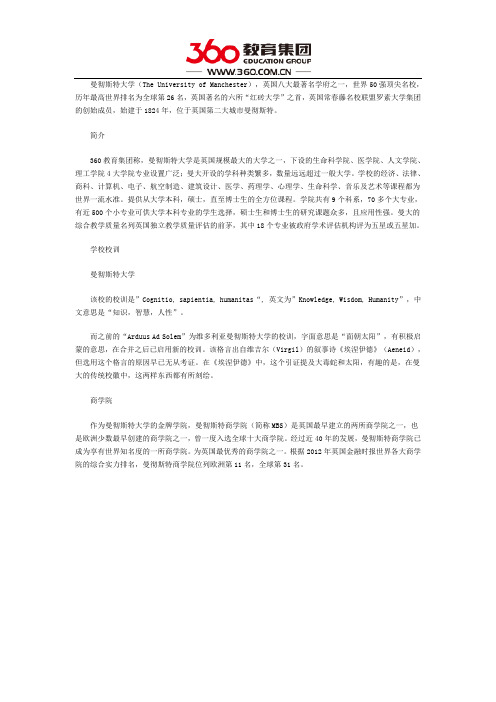
曼彻斯特大学(The University of Manchester),英国八大最著名学府之一,世界50强顶尖名校,历年最高世界排名为全球第26名,英国著名的六所“红砖大学”之首,英国常春藤名校联盟罗素大学集团的创始成员,始建于1824年,位于英国第二大城市曼彻斯特。
简介360教育集团称,曼彻斯特大学是英国规模最大的大学之一,下设的生命科学院、医学院、人文学院、理工学院4大学院专业设置广泛;曼大开设的学科种类繁多,数量远远超过一般大学。
学校的经济、法律、商科、计算机、电子、航空制造、建筑设计、医学、药理学、心理学、生命科学、音乐及艺术等课程都为世界一流水准。
提供从大学本科,硕士,直至博士生的全方位课程。
学院共有9个科系,70多个大专业,有近500个小专业可供大学本科专业的学生选择,硕士生和博士生的研究课题众多,且应用性强。
曼大的综合教学质量名列英国独立教学质量评估的前茅,其中18个专业被政府学术评估机构评为五星或五星加。
学校校训曼彻斯特大学该校的校训是”Cognitio, sapientia, humanitas“, 英文为”Knowledge, Wisdom, Humanity”,中文意思是“知识,智慧,人性”。
而之前的“Arduus Ad Solem”为维多利亚曼彻斯特大学的校训,字面意思是“面朝太阳”,有积极启蒙的意思,在合并之后已启用新的校训。
该格言出自维吉尔(Virgil)的叙事诗《埃涅伊德》(Aeneid),但选用这个格言的原因早已无从考证。
在《埃涅伊德》中,这个引证提及大毒蛇和太阳,有趣的是,在曼大的传统校徽中,这两样东西都有所刻绘。
商学院作为曼彻斯特大学的金牌学院,曼彻斯特商学院(简称MBS)是英国最早建立的两所商学院之一,也是欧洲少数最早创建的商学院之一,曾一度入选全球十大商学院。
经过近40年的发展,曼彻斯特商学院已成为享有世界知名度的一所商学院。
为英国最优秀的商学院之一。
根据2012年英国金融时报世界各大商学院的综合实力排名,曼彻斯特商学院位列欧洲第11名,全球第31名。
曼彻斯特大学qs
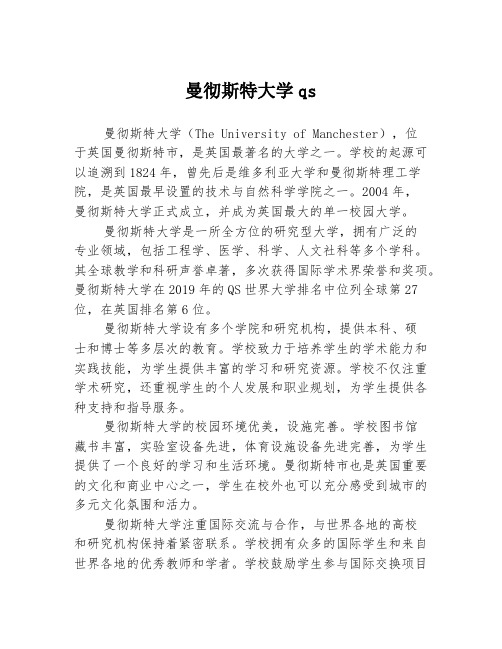
曼彻斯特大学qs曼彻斯特大学(The University of Manchester),位于英国曼彻斯特市,是英国最著名的大学之一。
学校的起源可以追溯到1824年,曾先后是维多利亚大学和曼彻斯特理工学院,是英国最早设置的技术与自然科学学院之一。
2004年,曼彻斯特大学正式成立,并成为英国最大的单一校园大学。
曼彻斯特大学是一所全方位的研究型大学,拥有广泛的专业领域,包括工程学、医学、科学、人文社科等多个学科。
其全球教学和科研声誉卓著,多次获得国际学术界荣誉和奖项。
曼彻斯特大学在2019年的QS世界大学排名中位列全球第27位,在英国排名第6位。
曼彻斯特大学设有多个学院和研究机构,提供本科、硕士和博士等多层次的教育。
学校致力于培养学生的学术能力和实践技能,为学生提供丰富的学习和研究资源。
学校不仅注重学术研究,还重视学生的个人发展和职业规划,为学生提供各种支持和指导服务。
曼彻斯特大学的校园环境优美,设施完善。
学校图书馆藏书丰富,实验室设备先进,体育设施设备先进完善,为学生提供了一个良好的学习和生活环境。
曼彻斯特市也是英国重要的文化和商业中心之一,学生在校外也可以充分感受到城市的多元文化氛围和活力。
曼彻斯特大学注重国际交流与合作,与世界各地的高校和研究机构保持着紧密联系。
学校拥有众多的国际学生和来自世界各地的优秀教师和学者。
学校鼓励学生参与国际交换项目和国际合作研究,提供丰富的机会和资源。
总之,曼彻斯特大学作为英国著名的大学之一,凭借卓越的教学和研究实力,培养了众多的优秀人才,为社会和经济发展做出了重要贡献。
无论是学术实力还是学生生活,曼彻斯特大学都能提供最好的支持和保障,为学生创造更加美好的未来。
曼彻斯特大学(TheUniversityofManchester)
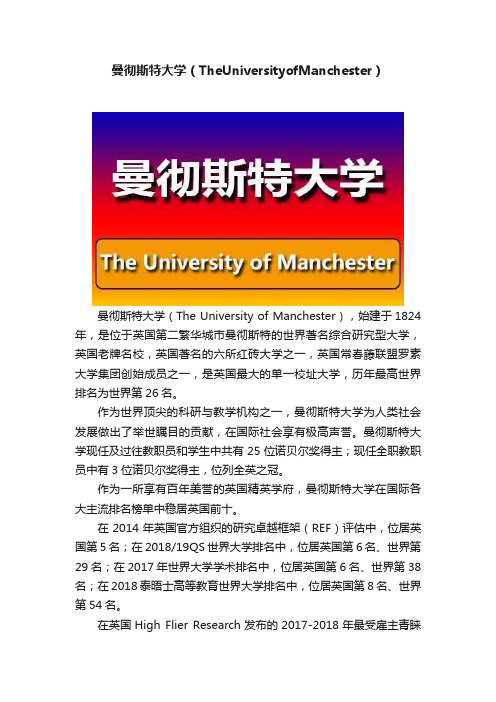
曼彻斯特大学(TheUniversityofManchester)曼彻斯特大学(The University of Manchester),始建于1824年,是位于英国第二繁华城市曼彻斯特的世界著名综合研究型大学,英国老牌名校,英国著名的六所红砖大学之一,英国常春藤联盟罗素大学集团创始成员之一,是英国最大的单一校址大学,历年最高世界排名为世界第26名。
作为世界顶尖的科研与教学机构之一,曼彻斯特大学为人类社会发展做出了举世瞩目的贡献,在国际社会享有极高声誉。
曼彻斯特大学现任及过往教职员和学生中共有25位诺贝尔奖得主;现任全职教职员中有3位诺贝尔奖得主,位列全英之冠。
作为一所享有百年美誉的英国精英学府,曼彻斯特大学在国际各大主流排名榜单中稳居英国前十。
在2014年英国官方组织的研究卓越框架(REF)评估中,位居英国第5名;在2018/19QS世界大学排名中,位居英国第6名、世界第29名;在2017年世界大学学术排名中,位居英国第6名、世界第38名;在2018泰晤士高等教育世界大学排名中,位居英国第8名、世界第54名。
在英国High Flier Research发布的2017-2018年最受雇主青睐英国大学排名中,曼彻斯特大学位居全英第1名,同时也是该排名发布13年来唯一稳居全英前三的大学。
英国高等教育政策研究所2015年发布的报告显示,曼彻斯特大学是培养出世界各国现任领导人第二多的英国大学(仅次于牛津大学)。
此外,曼大还是英国获得女王周年奖次数第二多的大学,仅次于牛津。
学院介绍商学院曼彻斯特商学院(简称Alliance MBS)是英国最早建立的两所商学院之一。
经过50年的发展,曼彻斯特商学院已成为一所享誉世界的商学院,为英国最优秀的商学院之一。
2014年英国研究卓越框架(REF)结果显示,曼彻斯特商学院在商业与管理学领域的“科研力量”(Research Power)位居全英第二。
根据2017年英国金融时报全球商学院MBA排名,曼彻斯特商学院位列英国第3名,欧洲第10名,世界第30名。
英国曼彻斯特大学介绍
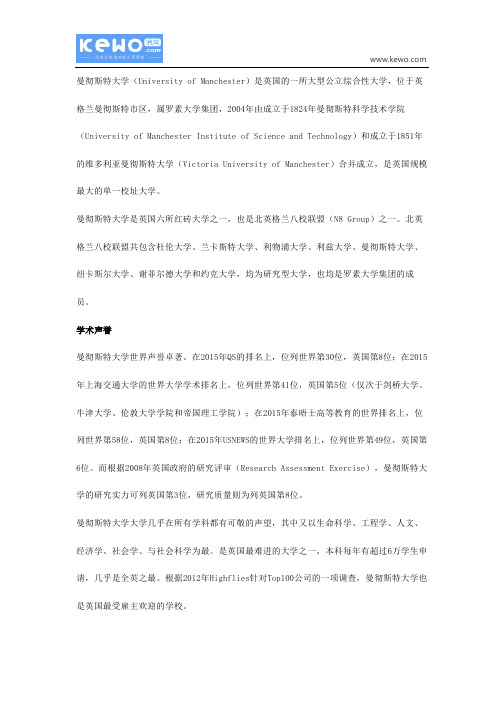
曼彻斯特大学(University of Manchester)是英国的一所大型公立综合性大学,位于英格兰曼彻斯特市区,属罗素大学集团,2004年由成立于1824年曼彻斯特科学技术学院(University of Manchester Institute of Science and Technology)和成立于1851年的维多利亚曼彻斯特大学(Victoria University of Manchester)合并成立,是英国规模最大的单一校址大学。
曼彻斯特大学是英国六所红砖大学之一,也是北英格兰八校联盟(N8 Group)之一。
北英格兰八校联盟共包含杜伦大学、兰卡斯特大学、利物浦大学、利兹大学、曼彻斯特大学、纽卡斯尔大学、谢菲尔德大学和约克大学,均为研究型大学,也均是罗素大学集团的成员。
学术声誉曼彻斯特大学世界声誉卓著。
在2015年QS的排名上,位列世界第30位,英国第8位;在2015年上海交通大学的世界大学学术排名上,位列世界第41位,英国第5位(仅次于剑桥大学、牛津大学、伦敦大学学院和帝国理工学院);在2015年泰晤士高等教育的世界排名上,位列世界第58位,英国第8位;在2015年USNEWS的世界大学排名上,位列世界第49位,英国第6位。
而根据2008年英国政府的研究评审(Research Assessment Exercise),曼彻斯特大学的研究实力可列英国第3位,研究质量则为列英国第8位。
曼彻斯特大学大学几乎在所有学科都有可敬的声望,其中又以生命科学、工程学、人文、经济学、社会学、与社会科学为最。
是英国最难进的大学之一,本科每年有超过6万学生申请,几乎是全英之最。
根据2012年Highflies针对Top100公司的一项调查,曼彻斯特大学也是英国最受雇主欢迎的学校。
曼彻斯特大学图书馆(约翰·莱兰兹图书馆)藏书量位居全英第三,仅次于牛津大学和剑桥大学。
曼彻斯特大学共诞生了25位诺贝尔奖得主(包括校友和教员),这个数量位居英国第四,主要集中于物理和化学领域,经济学奖有3位,生理医学奖有2位,文学奖则没有。
曼彻斯特大学专业介绍

曼彻斯特大学专业介绍曼彻斯特大学(The University of Manchester),英国大学中世界排名最高的八大最著名学府之一,世界50强顶尖名校,历年最高世界排名为全球第26名,英国著名的六所“红砖大学”之首,英国“常春藤联盟”罗素大学集团的创始成员之一,始建于1824年,位于英国第二繁华城市曼彻斯特,是英国最大的单一校址大学。
作为全球最为顶尖的科研与教学机构之一,曼彻斯特大学为人类社会的发展做出了举世瞩目的贡献,在国际上享有极高声誉。
那么,接下来美行思远小编就来和大家介绍一下曼彻斯特大学专业设置情况:曼彻斯特大学专业介绍时装零售设计管理学专业(Design Management for Fashion Retailing)BSc该专业隶属于材料学院,为3到4年,拿到的学位是理科学士学位。
对于国际学生来说,每年的学费为15,400英镑。
设计已经渗透到了生活的方方面面,而零售机构现在也急需设计管理学的专业人才,把设计和时装与管理和零售结合起来。
也正是市场对此类人才的需求,所以才有了时装零售设计管理学专业。
学生会先学习一些理论知识,然后是练习,最后把自己所学的专业知识在零售业中实践。
学生需要掌握信息通信技术和计算机辅助设计等专业技能,同时得对时尚管理、买者心理、产品的呈现方式等有一个透彻的理解。
时装和纺织零售业专业(Fashion & Textile Retailing)BSc该专业隶属于材料学院,学制为三年到四年,本科一年的学费为15,400英镑。
这个专业的学生肯定得对时装和市场有所了解,另外甚至时装设计过程也要略知一二。
开始会学习一些理论知识,例如时装管理、消费者行为等,主要是通过上课或者研讨会。
有可能四年才能毕业,主要取决于你二年级的期末成绩。
第三年主要是去市场时间,当然也可以去海外留学。
美术史专业(History of Art)BA该专业隶属于美术、历史和文化学院,学制为三年,每年学费为12,300英镑。
曼大认可的国内高校list

曼大认可的国内高校list一、引言曼彻斯特大学(The University of Manchester,简称曼大)是位于英国曼彻斯特的一所世界知名的综合性大学。
作为一所具有全球影响力的高等教育机构,曼大与众多国内高校保持着紧密的合作关系,并认可一些国内高校的学历。
本文将根据曼大认可的国内高校list,介绍一些获得曼大认可的国内高校,并简要介绍它们的特点和优势。
二、获得曼大认可的国内高校1. 清华大学清华大学是中国最顶尖的综合性大学之一,享有盛誉的本科和研究生教育机构。
曼大与清华大学保持着密切的合作关系,双方在学术交流、科研合作、师资培养等方面进行广泛合作。
清华大学的学生有机会申请曼大的交换生项目或者通过合作项目获得曼大的双学位。
2. 北京大学北京大学是中国历史最久、综合实力较强的一所大学,曾为曼大的合作伙伴。
曼大认可北京大学的学位,北京大学的学生能够通过直接申请或者合作项目的方式前往曼大进修,获得曼大的学习和研究经验。
3. 上海交通大学上海交通大学是一所享有盛誉的综合性高水平研究型大学,与曼大保持密切合作关系。
曼大认可上海交通大学的学位,并与之开展了多个合作项目,包括学生交流、共同研究、教师互访等。
上海交通大学的学生可以通过申请曼大的交换生项目,或者直接申请曼大的研究生课程。
4. 浙江大学浙江大学是中国著名的综合性研究型大学,曼大与浙江大学一直保持着良好的合作关系。
曼大认可浙江大学的学位,浙江大学的学生能够通过申请曼大的交换生项目或者直接申请曼大的研究生课程,获得曼大的学术资源和国际化教育背景。
5. 复旦大学复旦大学是中国一流的综合性研究型大学之一,与曼大有广泛的学术交流与合作项目。
曼大对复旦大学的学位持认可态度,复旦大学的学生可以申请曼大的交换生项目,或者通过合作项目获得曼大的学位。
三、结论以上所列的国内高校是曼大认可的一些知名高校。
这些高校在综合实力、教学质量、研究能力、国际化程度等方面均具有较高的水平。
英国曼彻斯特大学世界排名是多少
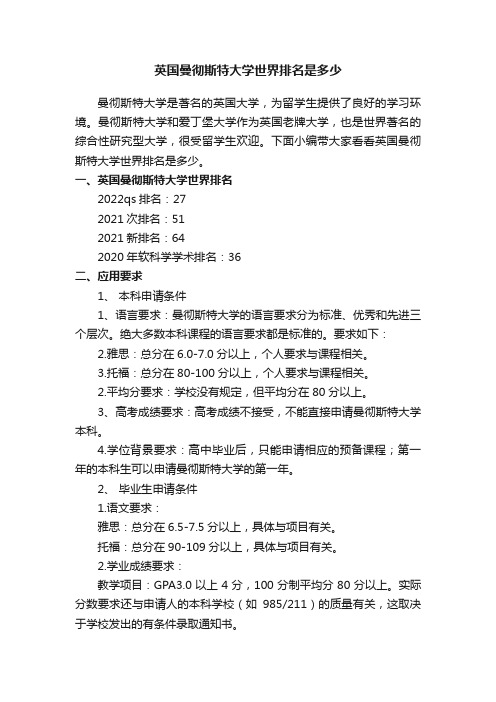
英国曼彻斯特大学世界排名是多少曼彻斯特大学是著名的英国大学,为留学生提供了良好的学习环境。
曼彻斯特大学和爱丁堡大学作为英国老牌大学,也是世界著名的综合性研究型大学,很受留学生欢迎。
下面小编带大家看看英国曼彻斯特大学世界排名是多少。
一、英国曼彻斯特大学世界排名2022qs排名:272021次排名:512021新排名:642020年软科学学术排名:36二、应用要求1、本科申请条件1、语言要求:曼彻斯特大学的语言要求分为标准、优秀和先进三个层次。
绝大多数本科课程的语言要求都是标准的。
要求如下:2.雅思:总分在6.0-7.0分以上,个人要求与课程相关。
3.托福:总分在80-100分以上,个人要求与课程相关。
2.平均分要求:学校没有规定,但平均分在80分以上。
3、高考成绩要求:高考成绩不接受,不能直接申请曼彻斯特大学本科。
4.学位背景要求:高中毕业后,只能申请相应的预备课程;第一年的本科生可以申请曼彻斯特大学的第一年。
2、毕业生申请条件1.语文要求:雅思:总分在6.5-7.5分以上,具体与项目有关。
托福:总分在90-109分以上,具体与项目有关。
2.学业成绩要求:教学项目:GPA3.0以上4分,100分制平均分80分以上。
实际分数要求还与申请人的本科学校(如985/211)的质量有关,这取决于学校发出的有条件录取通知书。
研究项目:本科平均成绩在80分以上。
一般来说,国内学生只有在硕士学位毕业后才能申请。
3.申请时间:研究项目通常全年均可申请,全年均可报名,但事实上,主要报名季节还是秋季;教学计划通常有一个固定的最后期限,这通常是迟来的,但其实质是实施滚动录取模式,在记录满时结束:只有少数项目需要它。
三、热门专业1、节约曼彻斯特大学经济系是欧洲经济研究的核心部门。
其专业排名位列英国前三。
最直接的表现是三位诺贝尔奖获得者多年来在这里教书。
据官方统计,90%的经济学专业毕业生能在半年内找到一份前景看好的工作,而且起薪也不低。
英国留学:曼彻斯特大学院系设置情况解析

英国留学:曼彻斯特大学院系设置情况解析英国留学:曼彻斯特大学院系设置情况解析曼彻斯特大学,简称曼大,是一所门类齐全,科系众多的综合性大学,位于曼城的市中心的大学村内。
曼大的前身是建于1851年的欧文斯学院,1880年升格为维克多利亚曼彻斯特大学,1903年被正式命名为曼彻斯特大学。
曼大以教学严谨,学术风气自由著称,创新作为教学和学术研究的主导思想,已形成传统。
本世纪很多关键的科学技术研究成果出自这里,如飞机发动机的研制,以及世界上第一台计算机的发明等。
曼大的综合教学质量名列英国独立教学质量评估的前茅,每年的大学综合评比,在英国120所大学中,始终名列前20名。
现在该校共有在校学生18000名,分别来自英国当地和世界其它国家,其中包括来自海外120个国家的2500名学生,全校现有教职员工3000名,其中很多是享誉世界的著名科学家。
曼彻斯特大学学院概况学校共有70多个科系,有近500个专业可供大学本科专业的学生选择,硕士生和博士生的研究课题众多,且应用性强。
曼大的综合教学质量名列英国独立教学质量评估的前茅,其中18个专业被最近政府学术评估机构评为五星或五星加。
学校所辖的学术机构如下:理学院:电子工程系:课程内容涉及电子和电机工程学,包括微量电子学、能量产生和能量分配等。
材料科学中心:主要研究冶金、聚合物、陶瓷和混合物等材料,其规模在欧洲首屈一指。
地质学系:是一个成立不久的新系,主要通过该系中教师学生联系委员会开展工作。
药学系:是一个随着药剂师的健康服务和药剂制造工业上日益重要性而新近发展起来的系。
物理系:是一个在教学和科研上都有很大成就的系,开设的'课程既有趣又实用。
继发现几亿年前的形成宇宙的大爆炸之后,该系又发现了一种操纵热宇宙的粒子和一种在绝对零度以上3度条件下的宇宙射线。
他们的研究内容几乎涉及到现代物理的所有领域。
数学系:是一个发展时间较长的系,如今拥有50名教师、50名研究生和450名本科生。
英国曼彻斯特大学本科申请条件 英国曼彻斯特大学世界排名第几
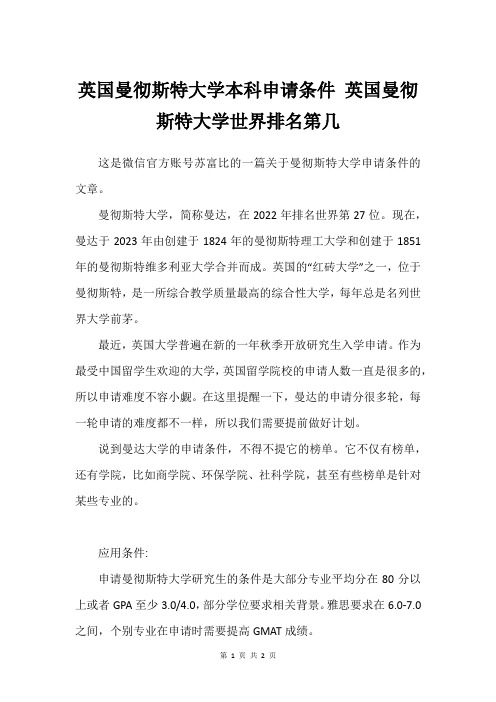
英国曼彻斯特大学本科申请条件英国曼彻斯特大学世界排名第几这是微信官方账号苏富比的一篇关于曼彻斯特大学申请条件的文章。
曼彻斯特大学,简称曼达,在2022年排名世界第27位。
现在,曼达于2023年由创建于1824年的曼彻斯特理工大学和创建于1851年的曼彻斯特维多利亚大学合并而成。
英国的“红砖大学”之一,位于曼彻斯特,是一所综合教学质量最高的综合性大学,每年总是名列世界大学前茅。
最近,英国大学普遍在新的一年秋季开放研究生入学申请。
作为最受中国留学生欢迎的大学,英国留学院校的申请人数一直是很多的,所以申请难度不容小觑。
在这里提醒一下,曼达的申请分很多轮,每一轮申请的难度都不一样,所以我们需要提前做好计划。
说到曼达大学的申请条件,不得不提它的榜单。
它不仅有榜单,还有学院,比如商学院、环保学院、社科学院,甚至有些榜单是针对某些专业的。
应用条件:申请曼彻斯特大学研究生的条件是大部分专业平均分在80分以上或者GPA至少3.0/4.0,部分学位要求相关背景。
雅思要求在6.0-7.0之间,个别专业在申请时需要提高GMAT成绩。
学费:曼彻斯特大学学生年平均生活费(住宿+生活费1023 * 12 = 12276英镑,人民币约11.6万元)。
曼彻斯特大学与世界各地的用人单位联系紧密,学生就业率高。
在英国毕业生就业市场研究机构High Flier Research发布的2023-2023年度最受雇主青睐的大学排名中,曼达大学位列英国第一,也是唯一一所连续10年排名英国前三的大学。
以上是明斯特大学申请条件的介绍。
作为QS的头部院校,申请还是比较难的,所以学生必须是学习成绩或者背景条件非常优秀的。
如果有同学,比如GPA,因为自身条件不够,还想去英国名校读书,不妨看看录取方案。
事实上,保送录取是指院校与名校有相对稳定的合作关系。
院校根据学生实际情况综合规划,利用个人人脉资源拓展学生自身背景,以合理的方式获得高校招生官等领导的内送名额,避免语言、GPA免试、低分高录,获得心仪院校的offer。
英国最好的10所大学
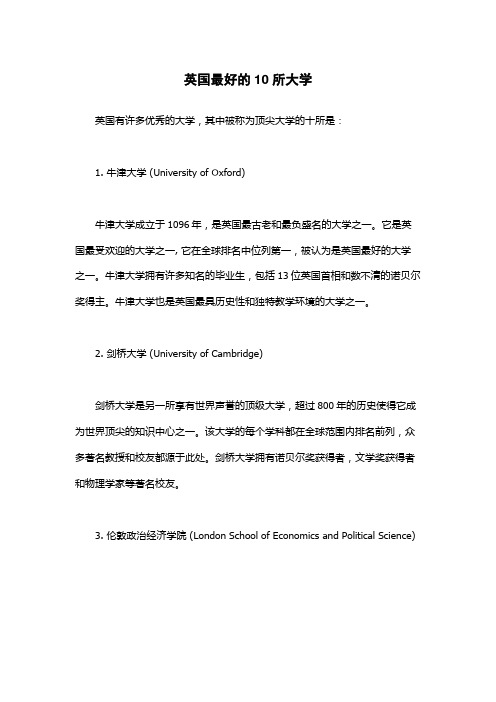
英国最好的10所大学英国有许多优秀的大学,其中被称为顶尖大学的十所是:1. 牛津大学 (University of Oxford)牛津大学成立于1096年,是英国最古老和最负盛名的大学之一。
它是英国最受欢迎的大学之一, 它在全球排名中位列第一,被认为是英国最好的大学之一。
牛津大学拥有许多知名的毕业生,包括13位英国首相和数不清的诺贝尔奖得主。
牛津大学也是英国最具历史性和独特教学环境的大学之一。
2. 剑桥大学 (University of Cambridge)剑桥大学是另一所享有世界声誉的顶级大学,超过800年的历史使得它成为世界顶尖的知识中心之一。
该大学的每个学科都在全球范围内排名前列,众多著名教授和校友都源于此处。
剑桥大学拥有诺贝尔奖获得者,文学奖获得者和物理学家等著名校友。
3. 伦敦政治经济学院 (London School of Economics and Political Science)伦敦政治经济学院是一所专注于社会科学和经济学的顶级大学。
该大学的聚光灯主要集中在政治经济学和管理学等领域,特别是在国际关系和政策领域上享有盛誉。
该大学著名的毕业生包括约翰·肯尼迪、安妮·锡莉和夏普东克。
4. 伦敦大学学院 (University College London)伦敦大学学院是著名的大学之一,其校友包括歌手克里斯·马丁和信用卡创业者克莱尔·巴拉特。
该大学在医学、经济学和心理学方面表现出色,并拥有大量世界级的研究设施。
5. 帝国理工学院 (Imperial College London)帝国理工学院是一所致力于科技和医学研究的优秀大学,从事高质量的教育和研究已超过100年。
该大学在计算机科学、工程学、物理学和医学等科学领域拥有世界领先地位,与许多多国公司进行合作。
6. 什罗普郡大学 (University of Warwick)什罗普郡大学是一所年轻而充满活力的顶级大学,它位于英格兰心脏地带,与许多国际组织进行紧密合作。
曼彻斯特大学简介

曼彻斯特大学The University of Manchester曼彻斯特大学位于英国的第3大城—曼彻斯特(Manchester)。
曼彻斯特总共有4所大学,除了曼彻斯特大学外,还有曼彻斯特理工(UMIST)、曼彻斯特城市大学(Manchester Metropolitan University)、University of Salford等3所大学。
除了University of Salford之外,其余的3所大学都座落在牛津街上(The Oxford Street)。
而这3所大学在地理位置上的相邻除了使得牛津街成为一个大学城外,也同时刺激了这3所大学在学术上的交流与学术资源的共享。
例如,在学生宿舍方面,曼彻斯特大学和曼彻斯特理工学院便使用同一个Accommodation Office,每间宿舍中都刻意混合两所学校的学生,来刺激彼此对校务的讨论。
而位于牛津街上的 Suqden Sports Center,Manchester Aquatic Center 与 Manchester Aquatic Center 等运动设备,也是这3所牛津街大学共同创设的。
让学生在念书的同时也能享受到一流的体育设施,达到纾解压力的效果。
曼彻斯特大学的前身是欧文学院(Owens College〉,成立于1851年。
欧文学院本来是一间男子大学,直到1903年改名为曼册斯特大学后才开始招收女生。
曼彻斯特大学是以商学院起家的。
直到1903年,校方才开设了艺术、理工与法律等相关科系。
1914年,成立教育学院。
而生物科技学院的建立(The school of Biological Science),是在1986年。
虽然这些学院的历史,在英国的高等教育界来说并不算悠久,从这些学院训练出来的学生,确广授业界的好评。
例如Biological Science、Law等科系在英国2001年RAE的大学评鉴中,都有第5级以上的成绩,学术成就惊人。
英国曼彻斯特大学院校概况以及特色专业

英国曼彻斯特大学院校概况以及特色专业学校名称:美国曼彻斯特大学(印第安纳州)所在位置:美国创建时间:1860QS排名:59录取率:0.64英国曼彻斯特大学是世界上一流的大学,成绩优异的同学们如果想要申请这所大学就和来看看英国曼彻斯特大学院校概况以及特色专业。
曼彻斯特大学作为世界知名一流的教学和科研机构,自1842年成立的曼彻斯特大学在国际上享有很高的声誉。
该校不仅培养了众多诺贝奖获得者,更在世界各大主流院校排名中稳居英国大学最前列。
曼彻斯特大学的校园特色曼大的学生可以享用到英国大学中顶级的设施。
曼大图书馆是全英第三大学术类图书馆,也是英国五个国家级研究型图书馆之一,共藏有400多万册各类纸质书籍与期刊,以及近100万电子书刊,还有几百个数据库。
为丰富学生的课外生活,曼大修建了两个室内运动中心、两个室外运动场和曼彻斯特水上活动中心,足以满足开展大部分体育运动的需要。
大学拥有的曼彻斯特博物馆全年向公众免费开放。
曼彻斯特大学的特色专业有哪些?(1)工科类专业曼大的化学工程专业一直以来都是英国甚至全世界的知名专业,而且所有课程设置都通过了英国化学工程协会的认可,专业度极高。
申请条件:985/211学生,均分85以上,双非学生均分88分以上。
雅思要求不低于6.5,单项不低于6.0。
(2)计算机类专业曼大是英国第一个开设计算机专业的学校,适应于计算机科学发展的方向,是很多计算机专业学生的最佳选择。
申请条件:雅思6.5,单项不低于6.0,均分要求85左右。
(3)教育学专业曼大的教育学专业教学质量高,申请要求没有商科等热门专业高,对学生的专业背景也没有强制要求。
申请条件:雅思6.5,写作6.5,其余单项不低于6.0,均分要求80左右。
(4)商科类专业曼大的金融相关专业开设非常早,距今已有百年历史,会计和金融专业也是英国同类专业中最好的之一。
申请条件:均分至少85以上,雅思6.5,单项不低于6.0,985/211学生,有相关专业背景更有优势。
英国最顶尖的十所大学

2022英国大学QS排名1、牛津大学。
牛津大学创办于1096年,位于英国牛津,是一所世界顶尖的公立研究型大学,在世界学术界有着崇高的地位和很大的影响力,培养了大批杰出人才。
2、剑桥大学。
剑桥大学成立于1209年,是一所享誉全球的公立研究型大学,大学自建校以来,共诞生了120位诺贝尔奖得主和15位英国首相,著名的生物学家达尔文也毕业于该校。
3、帝国理工学院。
帝国理工学院建立于1907年,是世界顶尖的公立研究型大学,在全球有着极高的声誉,大学共设有4个学院,提供本科和研究生教育。
4、伦敦大学学院。
伦敦大学学院创立于1826年,是伦敦的第一所大学,拥有雄厚的科研资金和优异的教学质量,自建校以来,共培养出35位诺贝尔奖得主。
5、爱丁堡大学。
爱丁堡大学创建于1583年,是一所享誉全球的顶级公立研究型大学,为世界培养了众多对人类社会发展做出突出贡献的人物,例如生物学家达尔文、我国工程院院士钟南山先生等。
6、曼彻斯特大学。
曼彻斯特大学始建于1824年,是一所世界顶尖的公立综合研究型大学,在欧洲乃至世界上都具有很大的影响力,以高质量的教学水平和严谨的学风著称。
7、伦敦国王学院。
伦敦国王学院创办于1829年,是英国久负盛名的世界顶尖公立综合研究型大学,在世界上享有盛誉,吸引着世界各地的学子。
8、伦敦经济政治学院。
伦敦经济政治学院创立于1895年,是享誉全球的顶尖公立研究型大学,学校共设有18个系,约有一半学生都来自海外不同国家,与我国的北京大学、清华大学都有交流合作。
9、华威大学。
华威大学创立于1965年,是一所公立综合类研究型大学,以优秀的教学及科研质量而享誉全球,具有卓越的学术水平。
10、布里斯托大学。
布里斯托大学始建于1876年,是一所世界百强名校,有着卓越的教学水平、先进的教学设备以及高素质的师资团队,培养出的学生都是未来的领导精英。
以上就是2022年QS英国排名前10名的大学,有意赴英的同学们可以作为参考,希望能够给您带来帮助。
- 1、下载文档前请自行甄别文档内容的完整性,平台不提供额外的编辑、内容补充、找答案等附加服务。
- 2、"仅部分预览"的文档,不可在线预览部分如存在完整性等问题,可反馈申请退款(可完整预览的文档不适用该条件!)。
- 3、如文档侵犯您的权益,请联系客服反馈,我们会尽快为您处理(人工客服工作时间:9:00-18:30)。
QS World University Rankings201430213332012
32
2011
29
2010
30
2009
26
2008
29
2007
30
Academic Ranking of World Universities
2014 38 2013 41 2012 40 2011 38 2010 44 2009 41 2008 40
The Jodrell Bank Discovery Centre
Our term-time education programme offers unique learning experiences at a site of current and world-leading science research. We cater for all learners; from Early Years pupils to Alevel students. You can choose from a wide range of workshops with our expert presenters, linking to many aspects of the science curriculum. On the day your pupils will also have the opportunity to explore our interactive exhibits and put their space questions to those in the know! Plus, we offer a host of teacher support resources, including downloadable classroom materials and pupil worksheets.
Founded in 2013 as an Arts Lab, The John Rylands Research Institute is a unique partnership between The University of Manchester Library and the Faculty of Humanities to conduct new research into the University's Special Collections.
Chemical 51-100 engineerin g 101150 50 Chemistry Accountin g and finance Computer Science and Informatio n Systems
40 17
43 51-100
Sociolog y Modern language s Statistics and Operatio n-al Research
We provide a world-leading environment and infrastructure and a supportive research culture that stimulates intellectual enquiry and the pursuit of research excellence, breaking new ground and championing interdisciplinary work
Manchester University, founded back in 1851 and granted its royal charter in 1903, is a giant of the north in a great student city. Living and studying here may change your life. There are more than 15,000 undergraduates and it attracts more applicants than any other university. Perhaps this is because of the good mix of arts and sciences that the university provides, as well as access to outstanding facilities, such as the third largest university library in the UK, the Jodrell Bank Science Centre with its radio telescope and 6,000 PCs clustered across the campus. Rutherford split the atom here. The students' union has four bars and two venues for live music, and there are over 100 student societies. All this goes some way to explaining Manchester's popularity .
The museum housed from 1835 in grand premises on Peter Street. In 1850 the museum absorbed the collections of the Manchester Geological Society. By the 1860s the Natural History Society had little money and the building was full. The museum was transferred in 1868 to Owens College, which later became the University of Manchester. Many more objects were donated and the Museum was extended in 1912-1913 and again in 1927,displayed new ethnographic and Egyptology collections. Over the twentieth century, the collection was split into archery, archaeology, botany, Egyptology, entomology, ethnography, mineralogy, palaeontology, numismatics and zoology, as well as live specimens in the aquarium and vivarium. Overall, the collection grew to six million items, and the staff expanded from four 'keepers' to over 70 museum professionals. Many of these were world-class scholars, and the Museum was the site for cutting-edge research in the natural sciences and humanities.
About the John Rylands Research Institute
The Institute brings together library professionals, humanities scholars and scientists to take research into new and unchartered territories.
14 33
Politics Medical science
43 40
40
37
51-100
English 51-100 language and literature
24
The John Rylands Library was founded by Enriqueta Rylands in memory of her husband John Rylands. In 1889 the architect Basil Champneys designed the striking gothic building, which took ten years to build and was opened to public readers on 1 January 1900. The library became part of The University of Manchester in 1972 and currently holds the Special Collections of The University of Manchester Library. Mrs Rylands' memorial to her husband is now part of the third largest academic library in the United Kingdom, and the Deansgate building houses over 250,000 printed volumes, and well over a million manuscripts and archival items.
The Lovell Telescope
We have no fewer than 25 Nobel Prize winners among our current and former staff, students and alumni.
